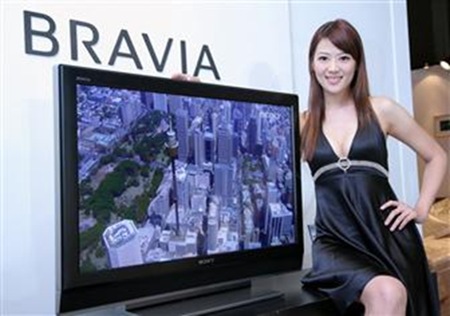The 3D TV system relies on a visual process called stereopsis. The eyes of an adult human lie about 2.5 inches apart, which lets each eye see objects from slightly different angles. The two images on a 3D TV screen present objects from two slightly different angles as well, and when those images combine in the viewer’s mind with the aid of the glasses, the illusion of depth is created.
How is the new 3D TV technology different from older 3D?
Most people are familiar with the old anaglyph method, where a pair of glasses with lenses tinted red and cyan (or other colors) is used to combine two false-color images.

The result seen by the viewer is discolored and usually lower-resolution than the new method. The principal improvements afforded by new 3D TV technologies are full color and high resolution–reportedly full 1080p HD resolution for both eyes in the Blu-ray 3D, for example, and half that resolution in the DirecTV system. We expect DirecTV’s 3D channels to look quite sharp despite lack of full 1080p resolution; see HDTV resolution explained for some reasons why.
HDTV and 3D TV
High-definition television (or HDTV, or just HD) refers to video having resolution substantially higher than traditional television systems (standard-definition TV, or SDTV, or SD). HD has one or two million pixels per frame, roughly five times that of SD. Early HDTV broadcasting used analog techniques, but today HDTV is digitally broadcast using video compression.
HDTV launched with superior resolution and digital surround sound. With HDTV, you could also play movies in their original widescreen format without the letterbox “black bars” that some people find annoying
LED TV
LED TVs are the newest technology in HDTV. LED High Definition Televisions use LED backlights replacing the standard Cold Cathode Fluorescent Lamps used in most LCD televisions. The display is still a conventional LCD but changing the back light.
LED-backlit LCD television (called LED TV by Samsung Electronics, Panasonic, Toshiba, Philips, LG Electronics, ProScan and Vizio and not to be confused with true LED displays) is an LCD TV that uses LED backlighting[1] rather than fluorescent lights used in traditional LCD televisions.
This technology enables the manufacturers to build thinner TV’s which can be less than two inches thick
3D TV and 3D TV Brands
3D-ready TV sets are those that can operate in 3D mode (in addition to regular 2D mode), in conjunction with LCD shutter glasses, where the TV tells the glasses which eye should see the image being exhibited at the moment, creating a stereoscopic image. These TV sets usually support HDMI 1.4 and a minimum (input and output) refresh rate of 120 Hz; glasses may be sold separately.Mitsubishi and Samsung utilize DLP technology from Texas Instruments
LG, Samsung, Sony & Philips intend to increase their 3D TV offering with plans to make 3D TV sales account for over 50% of their respective TV distribution offering by 2012
[3D TV Models & Brands] [ What is 3DTV] [3dTV Australia] [Comparison 3DtV HDTV LED TV] [3DTV is harmful] [3D TV Brands Online] [3D TV Glasses Price Quality] [3d TV Articles]
Gadget Australia – 3D TV Web Portal – YOUR ULTIMATE 3D TV WEB RESOURCE PORTAL




